Optimizing Station Placement for Free-Floating Electric Vehicle Sharing Systems: Leveraging Predicted User Spatial Distribution from Points of Interest
Abstract
:1. Introduction
2. Methodology
2.1. Station Radiation Scope
2.2. Demand Prediction
2.2.1. Data Resources
2.2.2. Index Selection and Construction
2.2.3. Model Construction
2.2.4. Model Test
2.3. Station Optimization Function and Content
2.3.1. Problem Description
2.3.2. Mathematical Formulation
| Notions | Descriptions |
| Sets | |
| set of all candidate stations for the location of rental stations, where N is the total number of rental stations; | |
| set of all candidate stations for the location of charging stations, where Q is the total number of charging stations; | |
| set of all candidate stations for the location of rental stations with charging function, where R is the total number of rental stations with charging function; | |
| set of demand from rental stations i to j at time step t; | |
| set of candidate trips during one day of operation; | |
| set of persons that perform trips ; | |
| set of relocation trips in one day; | |
| set of operational time steps in one day; | |
| set of relocation time steps in one day. | |
| Decision variables | |
| binary variable that defines if the trip uses the rental station and ; | |
| binary variable that defines if the charging trip uses the station and ; | |
| binary variable that defines if the relocation trip uses the charging station and rental station ; | |
| binary variable that defines if the relocation trip uses the rental station and ; | |
| integer variable that identifies the balance of EVs in rental station at time step ; | |
| ; | |
| integer variable that identifies the capacity of rental station ; | |
| integer variable that identifies the total EV fleet; | |
| integer variable that identifies the number of EVs in rental station at time step ; | |
| ; | |
| ; | |
| integer variable that identifies the number of EVs relocated from rental station to ; | |
| ; | |
| binary variable that defines if the person performs a trip. | |
| Data | |
| with an EV; | |
| with an EV; | |
| ; | |
| ; | |
| ; | |
| . | |
| Constants | |
| maximum capacity of rental stations; | |
| minimum capacity of rental stations; | |
| fare rate of an EV per minute at step ; | |
| fare rate of an EV per kilometer at step ; | |
| space cost in station for one EV per time at step ; | |
| docking cost of an electric vehicle per minute in rental station at step ; | |
| docking cost of an EV per minute in charging station at step ; | |
| ; | |
| fixed daily cost of each EV; | |
| maximum number of EVs in the system; | |
| total time traveled by all EVs; | |
| electric vehicle hourly driving subsidy; | |
| the normal trip distance of an EV with a fully charged state; | |
| the normal charging time of an EV. | |
3. Model Application
3.1. Data Setting
- (1)
- Apply the demand forecast model to determine the demand distribution of each electric vehicle sharing station;
- (2)
- geocode the potential depots for electric vehicles, using the current location of electric vehicle charging stations;
- (3)
- computing the travel times of the OD matrix that contains all the possible paths between depots using a GIS network shortest path algorithm with a digital elevation model. The differentiation of the shortest path for electric vehicles was included by disregarding the road altimetry variation;
- (4)
- computing the walking times for each candidate user from the determined location to the different potential depots.
3.2. Experimental Design
3.3. Results
3.4. Sensitivity Analyses
3.5. Compared Analyses
3.6. Practical Consideration
- (1)
- Governments should comprehensively investigate the citizens’ intentions, needs, and concerns regarding the use of EVS. In combination with the survey results and the original urban development plan, each jurisdiction should formulate an EVS development plan at different levels, regions, and phases.
- (2)
- Operation mode of shared vehicles should be deeply combined with the space-time demand distribution of shared vehicles. The spatial demand distributions of shared cars are always related to certain interest points. The time-demand distribution of shared cars is always related to the peak travel time of residents.
- (3)
- Optimization of the EVS station necessitates a multifaceted perspective. In addition to in-depth consideration of traffic demand, factors such as vehicle charging, vehicle scheduling, land use, operation cost, connection with other modes of transportation, balance and optimization of traffic structure, and sustainable development should also be considered.
- (4)
- Policymakers should employ diverse strategies for EVS development at different stages. In the early stages of the development of electric vehicle sharing, there is great economic and market pressure and more administrative thresholds. The government can formulate preferential incentive policies in terms of subsidies, taxation, and land use. For example, prioritizing the use of roads, parking resources, and other means to support the layout of electric vehicle sharing parking spaces and charging piles.
4. Concluding Remarks
- (1)
- The study focuses on Beijing, China, which may limit the generalizability of the findings to other urban contexts with different socio-economic profiles, transportation infrastructures, or cultural attitudes towards car-sharing. Different cities have unique points of interest (POIs), population densities, and travel patterns that could influence demand forecasting differently.
- (2)
- While the paper uses land characteristics and POIs to forecast demand, it might not fully capture the complexity of user behavior. Factors like weather conditions, time of day, special events, public transport availability, and individual preferences can significantly affect demand but are not mentioned in the abstract.
- (3)
- Although a sensitivity analysis is conducted, it focuses on varying demand and subsidy levels. Other external factors such as changes in fuel prices, EV technology advancements, or shifts in government policies, could also significantly influence the effectiveness of the planning model but are not explored.
- (1)
- Extend the study to include multiple cities with diverse urban structures and cultural backgrounds to validate the model’s universality and refine it for better adaptability across different regions.
- (2)
- Integrate real-time and big data sources (e.g., social media, traffic data, weather forecasts) into the demand forecasting model to enhance accuracy and responsiveness to immediate changes in user behavior.
- (3)
- Develop dynamic planning models that can continuously learn and adjust station placements and fleet sizes based on real-time usage patterns and emerging trends.
- (4)
- Explore the influence of user psychology and behavioral economics on car-sharing adoption. Understanding user incentives, perceived convenience, and trust in technology can inform strategies to boost user engagement and loyalty.
Author Contributions
Funding
Data Availability Statement
Conflicts of Interest
References
- FHWA. Highway Statistics; Federal Highway Administration, United States Department of Transportation: Washington, DC, USA, 2022.
- Bureau of Transportation Statistics. Pocket Guide to Transportation; U.S. Department of Transportation: Washington, DC, USA, 2023.
- Li, X.; Ma, J.; Cui, J.; Ghiasi, A.; Zhou, F. Design framework of large-scale one-way electric vehicle sharing systems: A continuum approximation model. Transp. Res. Part B Methodol. 2016, 88, 21–45. [Google Scholar] [CrossRef]
- Sun, L.; Wang, S.; Liu, S.; Yao, L.; Luo, W.; Ashish, S. A completive research on the feasibility and adaptation of shared transportation in mega-cities—A case study in Beijing. Appl. Energy 2018, 230, 1014–1033. [Google Scholar] [CrossRef]
- Martin, E.; Shaheen, S. The Impacts of Car2go on Vehicle Ownership, Modal Shift, Vehicle Miles Traveled, and Greenhouse Gas Emissions: An Analysis of Five North American Cities; Transportation Sustainability Research Center: Berkeley, CA, USA, 2018. [Google Scholar]
- Jiao, Z.; Ran, L.; Guan, L.; Wang, X.; Chu, H. Fleet management for Electric Vehicles sharing system under uncertain demand. In Proceedings of the International Conference on Service Systems and Service Management, Dalian, China, 16–18 June 2017. [Google Scholar]
- Xu, F.; Liu, J.; Lin, S.; Yuan, J. A vikor-based approach for assessing the service performance of electric vehicle sharing programs: A case study in Beijing. J. Clean. Prod. 2017, 148, 254–267. [Google Scholar] [CrossRef]
- Bi, H.; Ye, Z.; Zhao, J.; Chen, E. Mining bike sharing trip record data: A closer examination of the operating performance at station level. Transportation 2022, 51, 1015–1041. [Google Scholar] [CrossRef]
- Wang, S.; Li, Z.; Wang, B.; Li, M. Collision Avoidance Motion Planning for Connected and Automated Vehicle Platoon Merging and Splitting with A Hybrid Automaton Architecture. IEEE Trans. Intell. Transp. Syst. 2024, 2, 1445–1464. [Google Scholar] [CrossRef]
- Illgen, S.; Höck, M. Electric vehicles in car sharing networks—Challenges and simulation model analysis. Transp. Res. Part D Transp. Environ. 2018, 63, 377–387. [Google Scholar] [CrossRef]
- Guillot, M.; Furno, A.; Aghezzaf, E.H.; El Faouzi, N.E. Transport network downsizing based on optimal sub-network. Commun. Transp. Res. 2022, 2, 100079. [Google Scholar] [CrossRef]
- Arem, B.; Azedeh, S.S.; Snelder, M.; Hoogendoorn, S. Accessibility of urban regions on a low car diet—A research agenda for digital twins. Commun. Transp. Res. 2022, 2, 100077. [Google Scholar] [CrossRef]
- Boyacı, B.; Zografos, K.G.; Geroliminis, N. An optimization framework for the development of efficient one-way car-sharing systems. Eur. J. Oper. Res. 2015, 240, 718–733. [Google Scholar] [CrossRef]
- Barth, M.; Todd, M.; Xue, L. User-based vehicle relocation techniques for multiple-station shared-use vehicle systems. Transp. Res. Rec. 2004, 1887, 137–144. [Google Scholar] [CrossRef]
- Biondi, E.; Boldrini, C.; Bruno, R. Optimal charging of electric vehicle fleets for a car sharing system with power sharing. In Proceedings of the 2016 IEEE International Energy Conference (ENERGYCON), Leuven, Belgium, 4–8 April 2016; pp. 1–6. [Google Scholar]
- Correia, G.H.D.A.; Antunes, A.P. Optimization approach to depot location and trip selection in one-way carsharing systems. Transp. Res. Part E Logist. Transp. Rev. 2012, 48, 233–247. [Google Scholar] [CrossRef]
- Correia, G.H.D.A.; Jorge, D.R.; Antunes, D.M. The added value of accounting for users’ flexibility and information on the potential of a station-based one-way car-sharing system: An application in Lisbon, Portugal. J. Intell. Transp. Syst. 2024, 18, 299–308. [Google Scholar] [CrossRef]
- Lin, J.; Chen, Q.; Kawamura, K. Sustainability SI: Logistics cost and environmental impact analyses of urban delivery consolidation strategies. Netw. Spat. Econ. 2016, 16, 227–253. [Google Scholar] [CrossRef]
- Hu, L.; Liu, Y. Joint design of parking capacities and fleet size for one-way station-based carsharing systems with road congestion constraints. Transp. Res. Part B Methodol. 2016, 93, 268–299. [Google Scholar] [CrossRef]
- Heilig, M.; Mallig, N.; Schröder, O.; Kagerbauer, M.; Vortisch, P. Implementation of free-floating and station-based carsharing in an agent-based travel demand model. Travel Behav. Soc. 2017, 12, 151–158. [Google Scholar] [CrossRef]
- Huang, K.; Correia, G.H.D.A.; An, K. Solving the station-based one-way carsharing network planning problem with relocations and non-linear demand. Transp. Res. Part C Emerg. Technol. 2018, 90, 1–17. [Google Scholar] [CrossRef]
- Ahmad, F.; Iqbal, A.; Ashraf, I.; Marzband, M. Optimal location of electric vehicle charging station and its impact on distribution network: A review. Energy Rep. 2022, 8, 2314–2333. [Google Scholar] [CrossRef]
- Nourinejad, M.; Zhu, S.; Bahrami, S.; Roorda, M.J. Vehicle relocation and staff rebalancing in one-way carsharing systems. Transp. Res. Part E Logist. Transp. Rev. 2015, 81, 98–113. [Google Scholar] [CrossRef]
- Jorge, D.; Correia, G.H.A.; Barnhart, C. Comparing optimal relocation operations with simulated relocation policies in one-way carsharing systems. IEEE Trans. Intell. Transp. Syst. 2017, 15, 1667–1675. [Google Scholar] [CrossRef]
- You, P.S.; Hsieh, Y.C. A study on the vehicle size and transfer policy for car rental problems. Transp. Res. Part E Logist. Transp. Rev. 2014, 64, 110–121. [Google Scholar] [CrossRef]
- Ataç, S.; Obrenović, N.; Bierlaire, M. Vehicle sharing systems: A review and a holistic management framework. EURO J. Transp. Logist. 2021, 10, 100033. [Google Scholar] [CrossRef]
- Kaspi, M.; Raviv, T.; Tzur, M.; Galili, H. Regulating vehicle sharing systems through parking reservation policies: Analysis and performance bounds. Eur. J. Oper. Res. 2016, 251, 969–987. [Google Scholar] [CrossRef]
- Spieser, K.; Samaranayake, S.; Gruel, W.; Frazzoli, E. Shared-vehicle mobility-on-demand systems: A fleet operator’s guide to rebalancing empty vehicles. In Proceedings of the Transportation Research Board 95th Annual Meeting, Washington, DC, USA, 10–14 January 2016. [Google Scholar]
- Jian, S.; Rashidi, T.H.; Wijayaratna, K.P.; Dixit, V.V. A Spatial Hazard-Based analysis for modelling vehicle selection in station-based carsharing systems. Transp. Res. Part C Emerg. Technol. 2016, 72, 130–142. [Google Scholar] [CrossRef]
- Sun, D.; Chen, S.; Zhang, C.; Shen, S. Bus route evaluation model based on GIS and super-efficient data envelopment analysis. Transp. Plan. Technol. 2016, 39, 407–423. [Google Scholar] [CrossRef]
- Wang, S.; Sun, L.; Rong, J.; Hao, S.; Luo, W. Transit trip distribution model considering land use differences between catchment areas. J. Adv. Transp. 2016, 50, 1820–1830. [Google Scholar] [CrossRef]
- Guo, Y.; Kelly, J.A.; Clinch, J.P. Variability in total cost of vehicle ownership across vehicle and user profiles. Commun. Transp. Res. 2022, 2, 100071. [Google Scholar] [CrossRef]
- Wang, S.; Ma, J.; Cao, Q.; Wang, L. Environmental Benefits and Supply Dynamics of Electric Vehicles Sharing: From A Systematic Perspective of Transportation Structure and Trip Purposes. Transp. Res. Part D Transp. Environ. 2024, 130, 104193. [Google Scholar] [CrossRef]
- Wang, S.; Song, Z. Exploring the Behavioral Stage Transition of Traveler’s Adoption of Carsharing: An integrated choice and latent variable model. J. Choice Model. 2024, 51, 100447. [Google Scholar] [CrossRef]
- Liu, Y.; Wu, F.; Liu, Z.; Wang, K.; Wang, F.; Qu, X. Can language models be used for real-world urban-delivery route optimization? Innovation 2023, 4, 100520. [Google Scholar] [CrossRef] [PubMed]
- Beijing Transportation Institute. Beijing Traffic Development Annual Report. 2021. Available online: https://www.bjtrc.org.cn/List/index/cid/7.html (accessed on 5 November 2018).
- Liu, Y.; Jia, R.; Ye, J.; Qu, X. How machine learning informs ride-hailing services: A survey. Commun. Transp. Res. 2022, 2, 100075. [Google Scholar] [CrossRef]

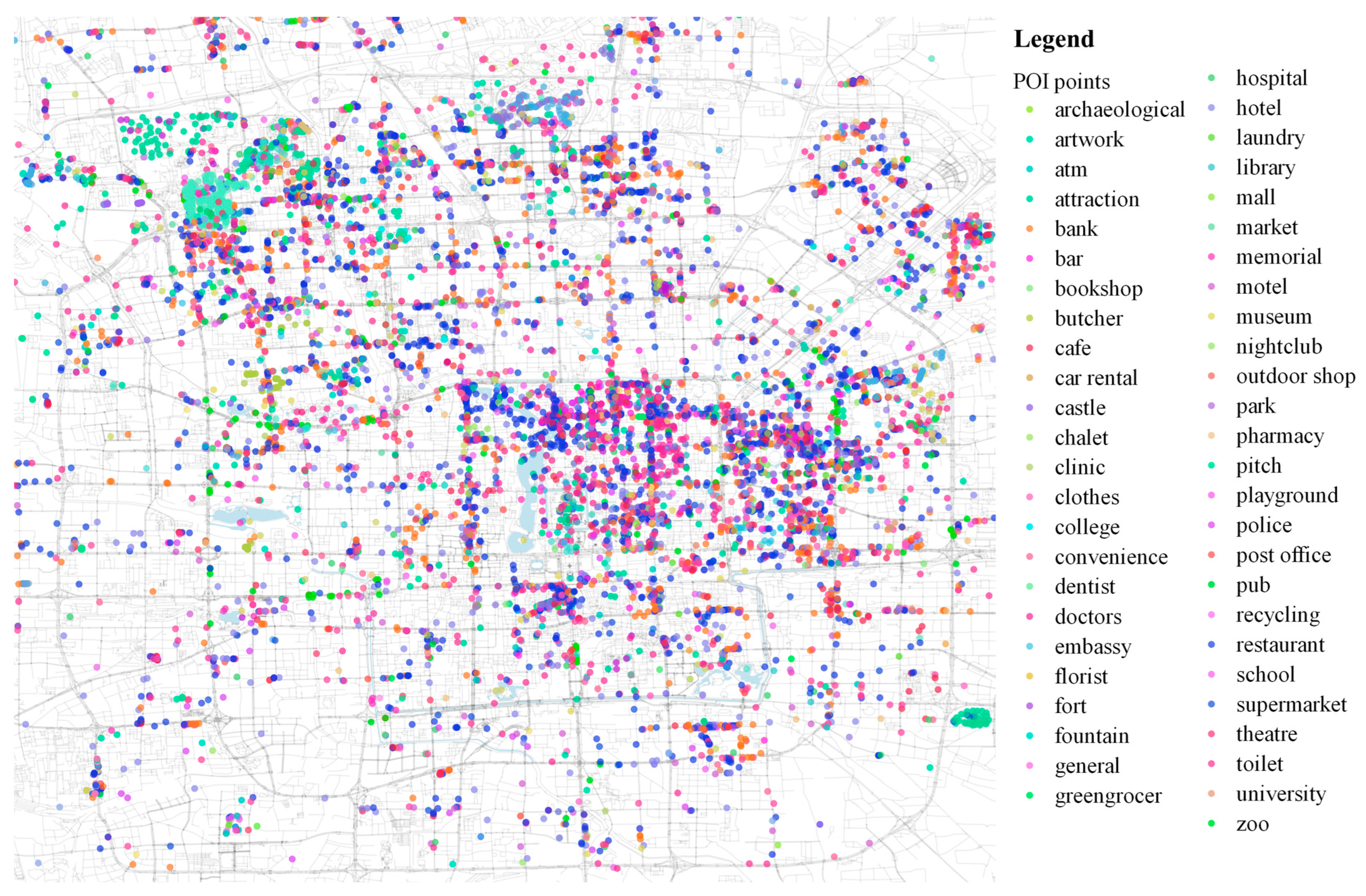
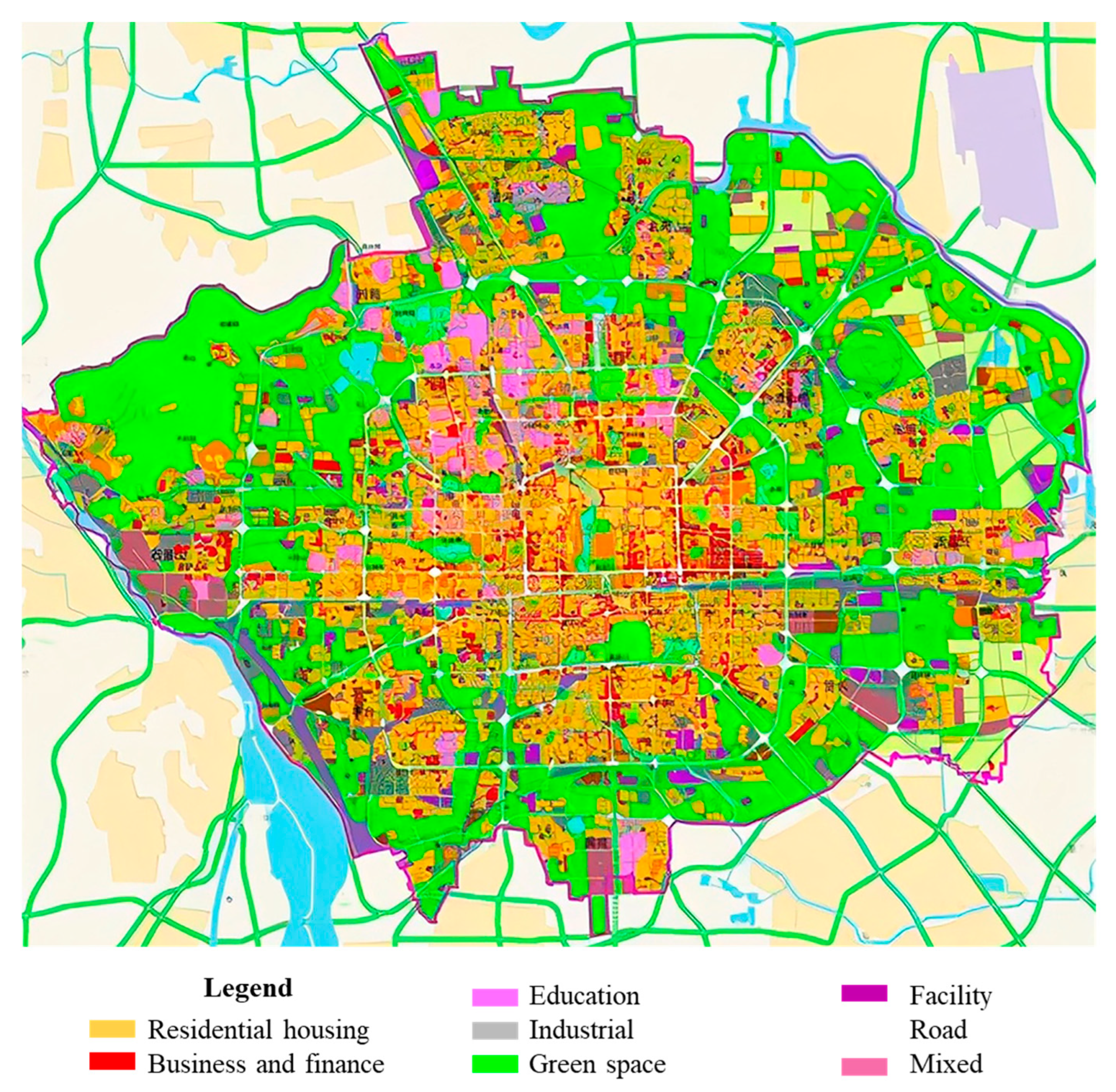
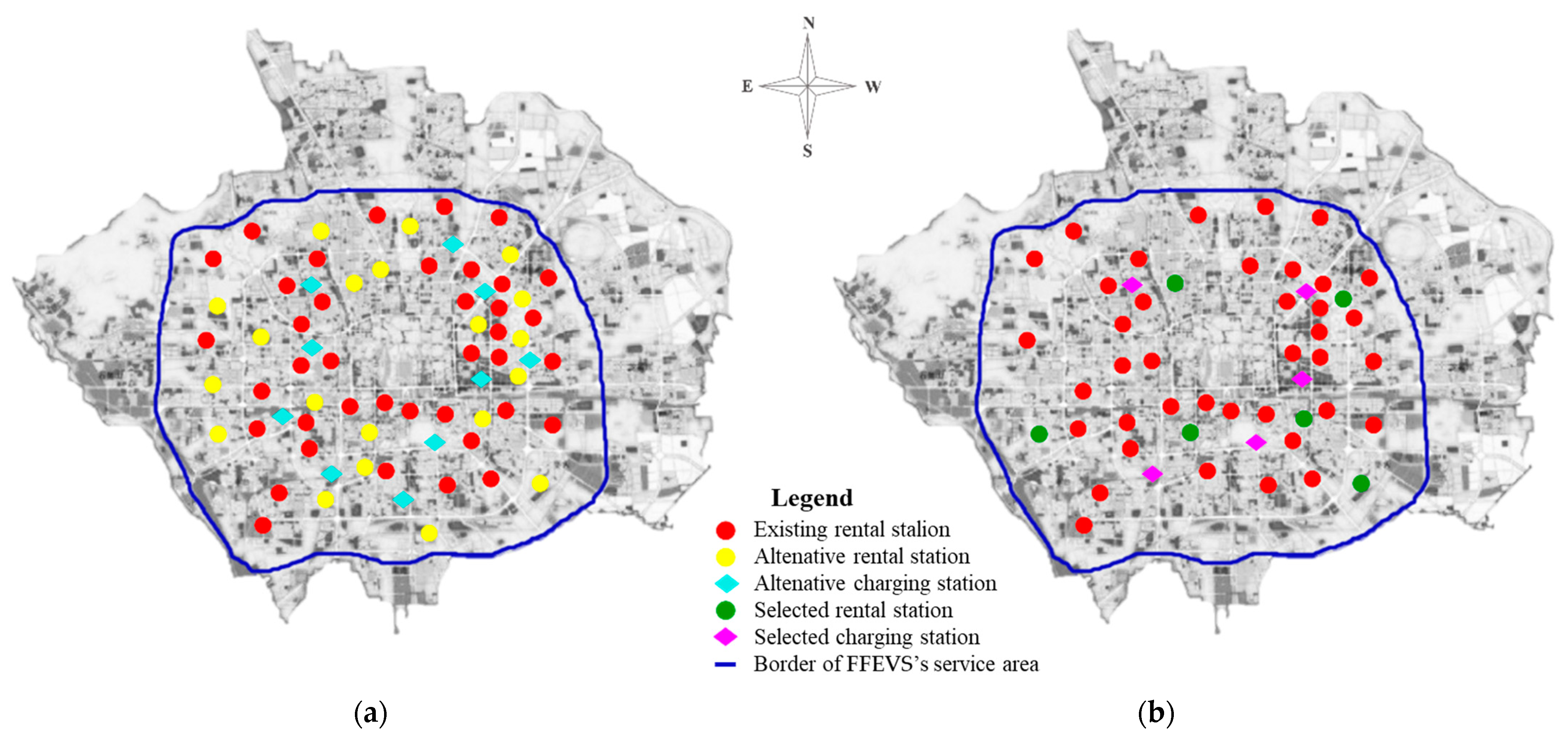
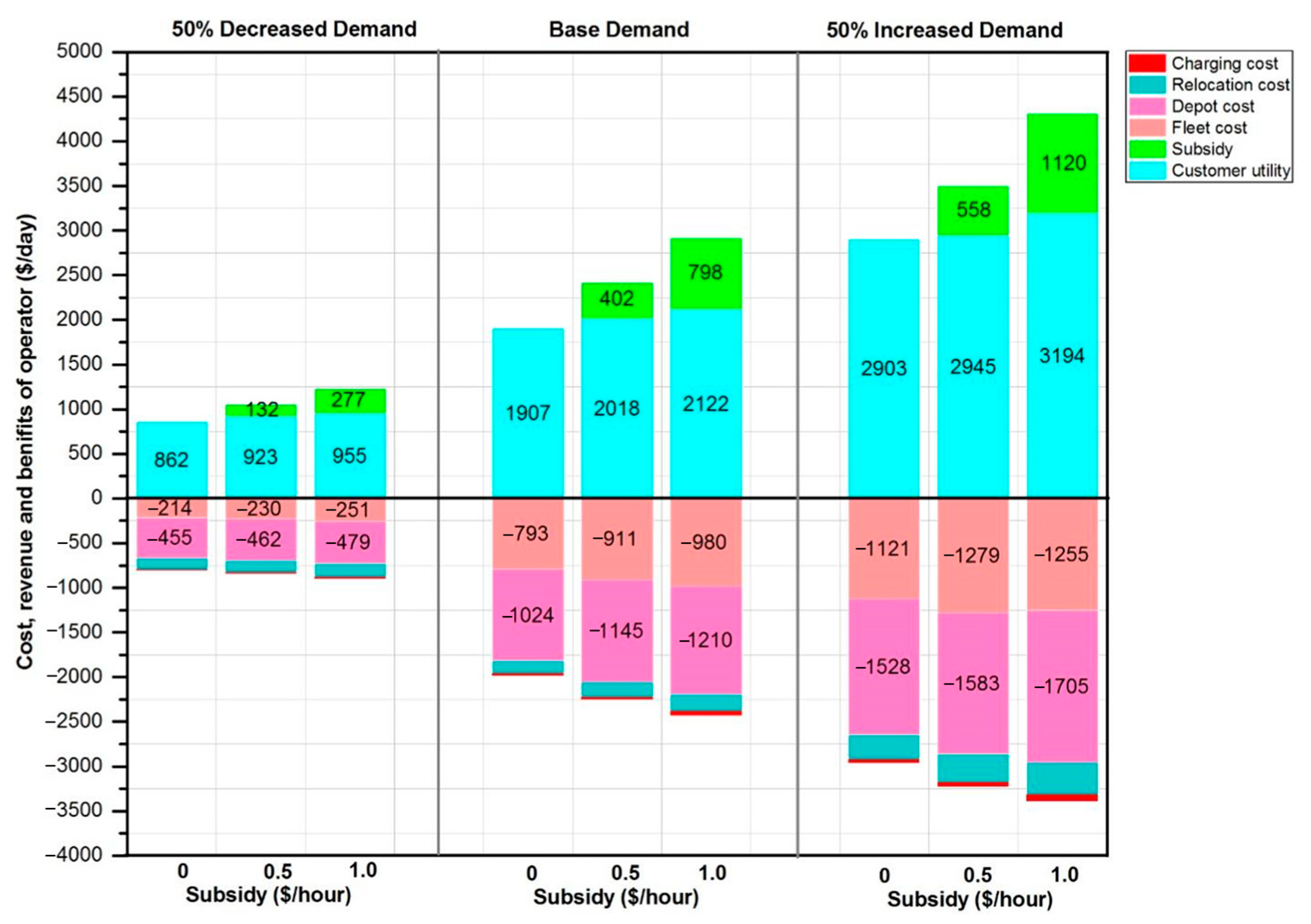
| Reference | Research Object | Research Contents | Research Method |
|---|---|---|---|
| [13] | EVS | Fleet size, the number and location of the required stations. | A multi-objective mixed integer linear programming with maximization of the net revenue for both operator and users. |
| [16] | Carsharing | The best number, location and capacities of stations. | An MIP model with the objective of the maximization of the operator’s profits. |
| [17] | Carsharing | Location of rental station, vehicle fleet size. | An MIP optimization model considering trips and station locations are freely selected by the system for profit maximization. |
| [18] | EVS | Location of rental station, vehicle inventories, system framework. | A CA approach basically approximates each local neighborhood of a space with an infinite homogeneous plane (IHP), |
| [19] | Carsharing | Fleet size, reservation policy, parking capacity. | A mixed queuing network model with consideration of road congestion and booking policy. |
| [20] | Carsharing | Travel demand | An agent-based travel demand model integrating station-based and free-floating carsharing |
| [21] | Carsharing | Location of rental station, station capacity and fleet size problem | A MILP model aims to maximize the daily profit of the carsharing operator. |
| [22] | Carsharing | Vehicle fleet size and relocation, spatiotemporal demand | A spatial decision support system that assists operators in countering imbalances between supply and demand. |
| [23] | Carsharing | Vehicle relocation and staff rebalancing | A joint optimization model for vehicle relocation and staff rebalancing using two integrated m-TSP formulations. |
| [24] | Carsharing | Vehicle relocation | A mathematical programming and a simulation model with the profitability of the CSO |
| [25] | Carsharing | Fleet size and vehicle transfer | A constrained nonlinear integer-programming model within an environment of dynamic demand |
| [26] | Carsharing | Location of rental station, vehicle fleet size. | An MIP approach accounts for vehicle stock imbalances by relocating vehicles at the end of the day. |
| [27] | Carsharing | Station and vehicle parking | A MILP approach based on network flow model |
| [28] | Carsharing | Fleet size and vehicle relocation | A simulation approach where the actual rental data of a free-floating carsharing system is embedded |
| [29] | Carsharing | Station and vehicle selection | A behavioral model to gain a greater understanding of users’ selecting vehicles. |
| Station of Origin | Booking Time | Order Amount | Picking Up Time | Dropping Off Time | Station of Destination |
|---|---|---|---|---|---|
| 1 | 20:38:59 | 27.34 | 20:49:42 | 21:12:43 | B1 |
| A2 | 20:41:21 | 37.03 | 21:11:19 | 21:42:10 | B2 |
| A3 | 20:42:08 | 57.51 | 20:42:20 | 22:28:23 | B3 |
| A4 | 20:43:33 | 58.34 | 21:01:52 | 23:42:50 | B4 |
| A5 | 20:44:40 | 18.65 | 20:45:02 | 23:11:08 | B5 |
| Sig. | |||||||
|---|---|---|---|---|---|---|---|
| 0.818 | 0.000 | 0.783 | 0.084 | 0.022 | - | - | |
| 0.735 | 0.000 | 0.001 | 0.103 | 0.015 | - | - | |
| 0.765 | 0.000 | 0.849 | 0.223 | 0.006 | - | - | |
| 0.772 | 0.000 | 0.793 | 0.100 | 0.126 | - | - | |
| 0.772 | - | 0.124 | 0.130 | 0.089 | 0.001 | 0.000 | |
| Station | 24 | 25 | 26 | 27 | 28 | 29 | Mean | |||
|---|---|---|---|---|---|---|---|---|---|---|
| Error | ||||||||||
| Model | ||||||||||
| −14.10% | 0.60% | −10.30% | 2.90% | −17.90% | −14.40% | 10.05% | ||||
| −11.31% | 4.62% | 12.44% | −8.13% | 11.61% | −13.25% | 10.23% | ||||
| −18.26% | 20.24% | 13.28% | 26.02% | 18.43% | −6.35% | 17.08% | ||||
| 10.27% | 18.75% | −8.74% | −1.17% | −6.19% | 18.08% | 10.53% | ||||
| 12.32% | 9.85% | −7.44% | 16.74% | −14.66% | −8.21% | 11.54% | ||||
| Research Scenarios | Rental Station Set | Charging Station Set | ||
|---|---|---|---|---|
| Code | Demand | Subsidy (RMB/h) | ||
| Scenario 1 | −50% | 0 | {41, 42, 47, 51, 54, 55, 58} | {61, 63, 64, 67, 68, 70} |
| Scenario 2 | −50% | 3 | {41, 42, 46, 51, 54, 55, 58} | {61, 62, 63, 64, 67, 68} |
| Scenario 3 | −50% | 6 | {41, 42, 46, 51, 53, 54, 55} | {61, 64, 65, 67, 68, 69} |
| Scenario 4 | Base | 0 | {41, 42, 43, 51, 54, 55, 58} | {61, 63, 65, 67, 68, 70} |
| Scenario 5 | Base | 3 | {41, 42, 43, 51, 52, 54, 55} | {61, 63, 64, 66, 67, 68} |
| Scenario 6 | Base | 6 | {41, 42, 44, 51, 54, 55, 58} | {61, 63, 64, 66, 68, 69} |
| Scenario 7 | +50% | 0 | {41, 42, 47, 51, 54, 55, 56} | {61, 62, 63, 64, 67, 68} |
| Scenario 8 | +50% | 3 | {41, 42, 44, 51, 54, 55, 56} | {61, 63, 64, 66, 67, 68} |
| Scenario 9 | +50% | 6 | {41, 42, 44, 51, 53, 54, 55} | {61, 62, 65, 64, 67, 68} |
| Grid Arrangement | Random Arrangement | Our Method | |
|---|---|---|---|
| Layouts * | 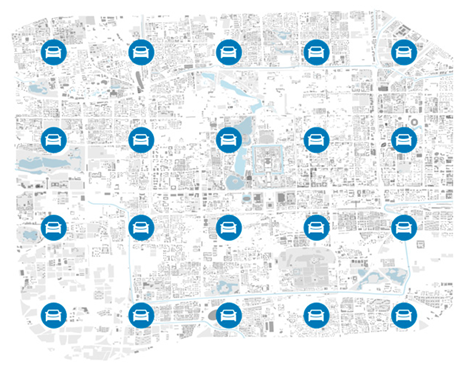 | 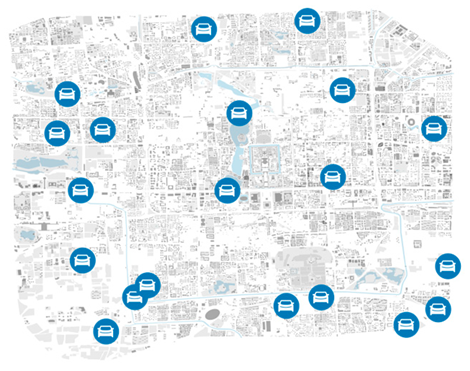 (One example of five trials) | 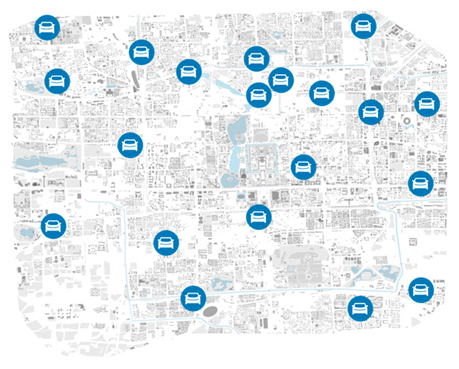 |
| Cost (RMB/day) | −1750 | −2231 (average value of five trials) | −2170 |
| Revenue (RMB/day) | 2002 | 1764 (average value of five trials) | 2817 |
 EVS station.
EVS station.Disclaimer/Publisher’s Note: The statements, opinions and data contained in all publications are solely those of the individual author(s) and contributor(s) and not of MDPI and/or the editor(s). MDPI and/or the editor(s) disclaim responsibility for any injury to people or property resulting from any ideas, methods, instructions or products referred to in the content. |
© 2024 by the authors. Licensee MDPI, Basel, Switzerland. This article is an open access article distributed under the terms and conditions of the Creative Commons Attribution (CC BY) license (https://creativecommons.org/licenses/by/4.0/).
Share and Cite
Cao, Q.; Wang, S.; Wang, B.; Ma, J. Optimizing Station Placement for Free-Floating Electric Vehicle Sharing Systems: Leveraging Predicted User Spatial Distribution from Points of Interest. ISPRS Int. J. Geo-Inf. 2024, 13, 233. https://doi.org/10.3390/ijgi13070233
Cao Q, Wang S, Wang B, Ma J. Optimizing Station Placement for Free-Floating Electric Vehicle Sharing Systems: Leveraging Predicted User Spatial Distribution from Points of Interest. ISPRS International Journal of Geo-Information. 2024; 13(7):233. https://doi.org/10.3390/ijgi13070233
Chicago/Turabian StyleCao, Qi, Shunchao Wang, Bingtong Wang, and Jingfeng Ma. 2024. "Optimizing Station Placement for Free-Floating Electric Vehicle Sharing Systems: Leveraging Predicted User Spatial Distribution from Points of Interest" ISPRS International Journal of Geo-Information 13, no. 7: 233. https://doi.org/10.3390/ijgi13070233






